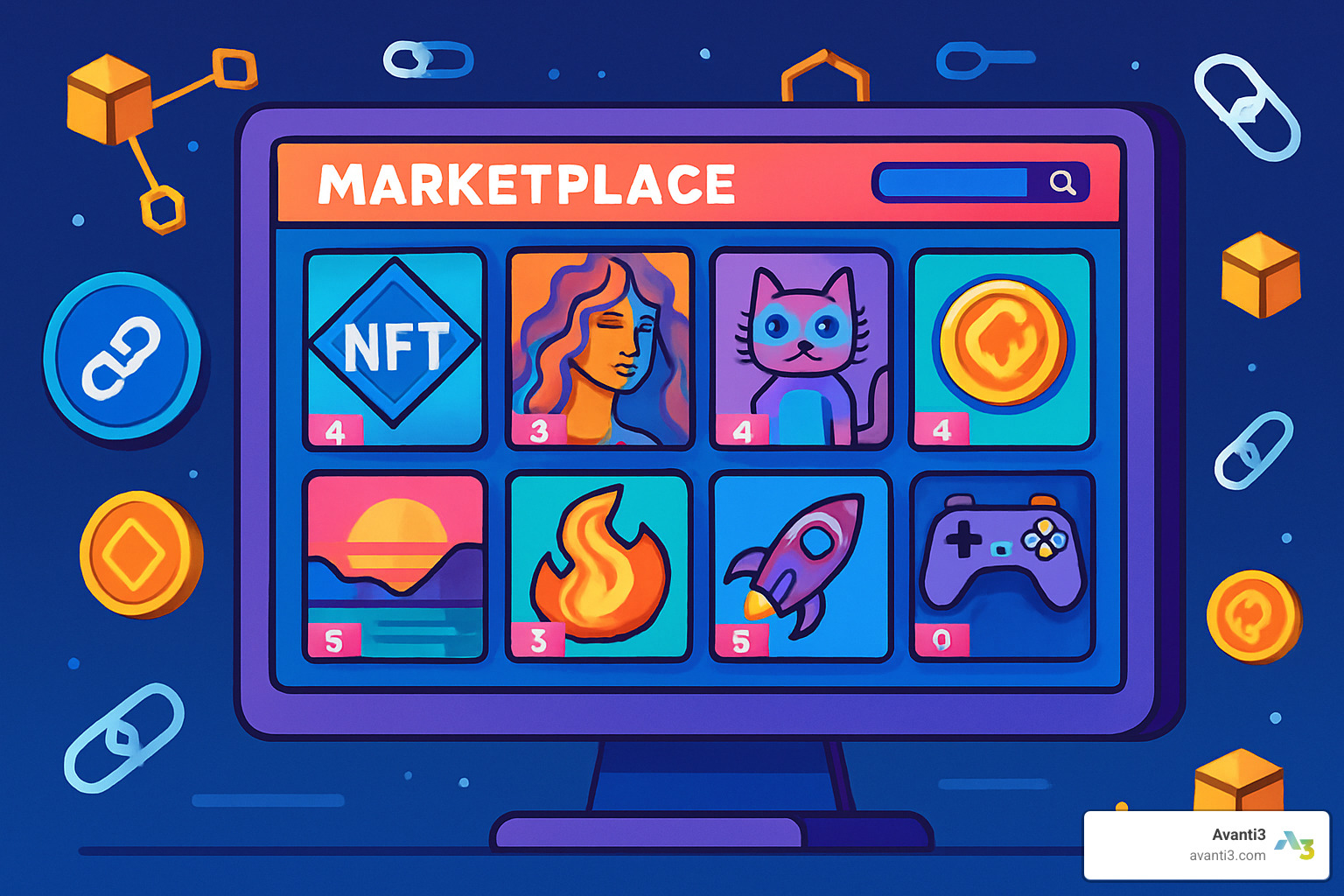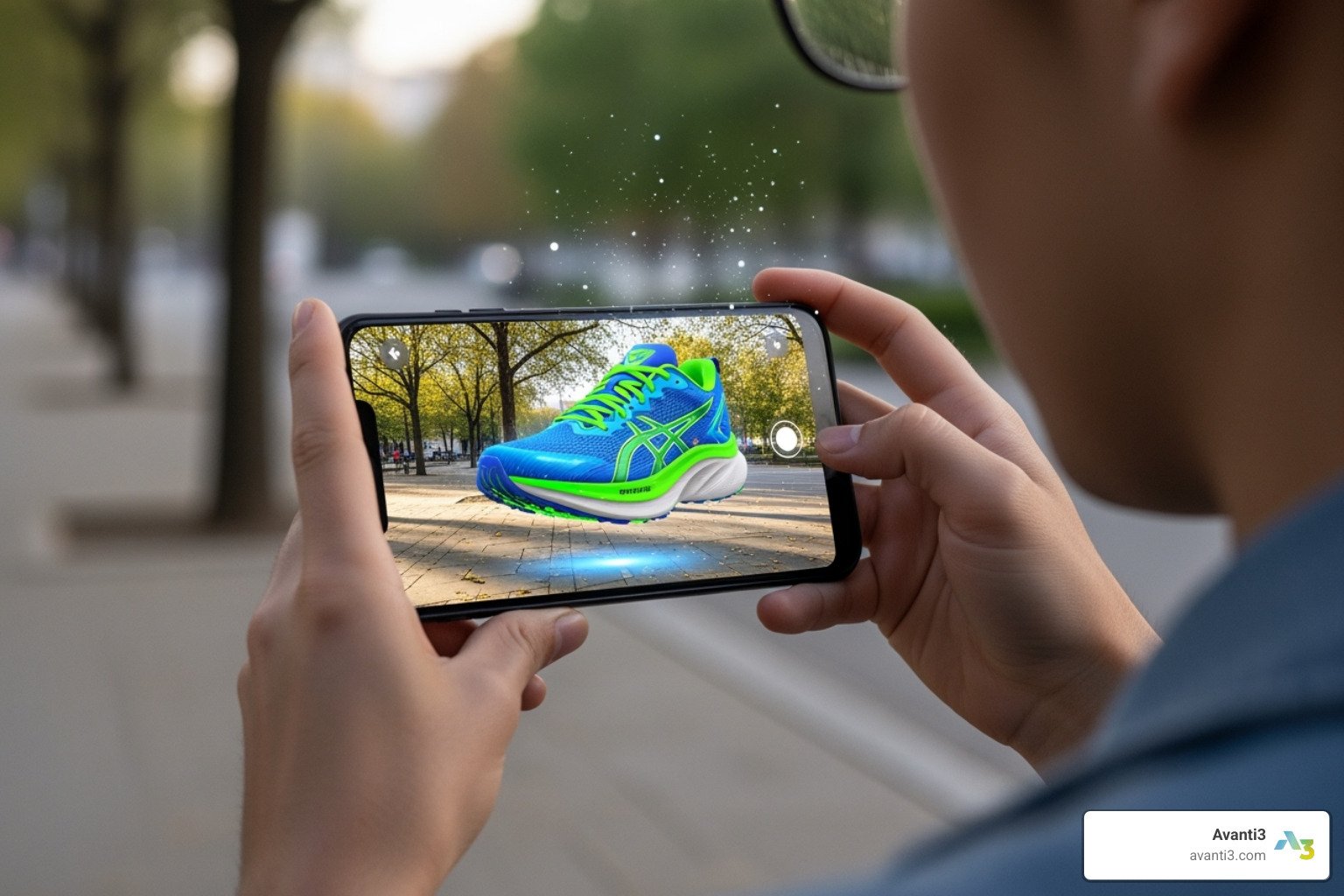Digital Collectibles Marketplace: Top 10 Best Picks 2025
Why Digital Collectibles Marketplaces Are Revolutionizing Creator Economy
A Digital Collectibles Marketplace is an online platform where users can buy, sell, and trade blockchain-based digital assets like NFTs, gaming items, sports moments, and digital art. These marketplaces use smart contracts to ensure authentic ownership and enable creators to monetize their work directly.
Top Digital Collectibles Marketplaces in 2025:
- Gaming NFT platforms supporting WAX, Polygon, and Immutable zkEVM
- Sports moments marketplaces with gamified features and live drops
- Licensed collectibles from major entertainment brands with AR showrooms
- Art marketplaces with affordable transaction fees
- Sports highlights with multiple rarity tiers
The digital collectibles space has exploded beyond simple art trading. Platforms now offer virtual showrooms, augmented reality features, and reward systems that blur the lines between collecting and gaming.
Key benefits include:
– Global 24/7 trading access
– Instant ownership verification
– Creator royalties on resales
– No physical storage limitations
– Cross-platform interoperability
However, challenges remain with platform risks, fee structures, and market volatility continuing to impact user experience.
I’m Samir ElKamouny AV, and I’ve helped countless businesses steer the Web3 landscape and open up new revenue streams through innovative digital engagement strategies. My experience scaling ventures in the Digital Collectibles Marketplace space has shown me how these platforms can transform creator-audience relationships when implemented strategically.
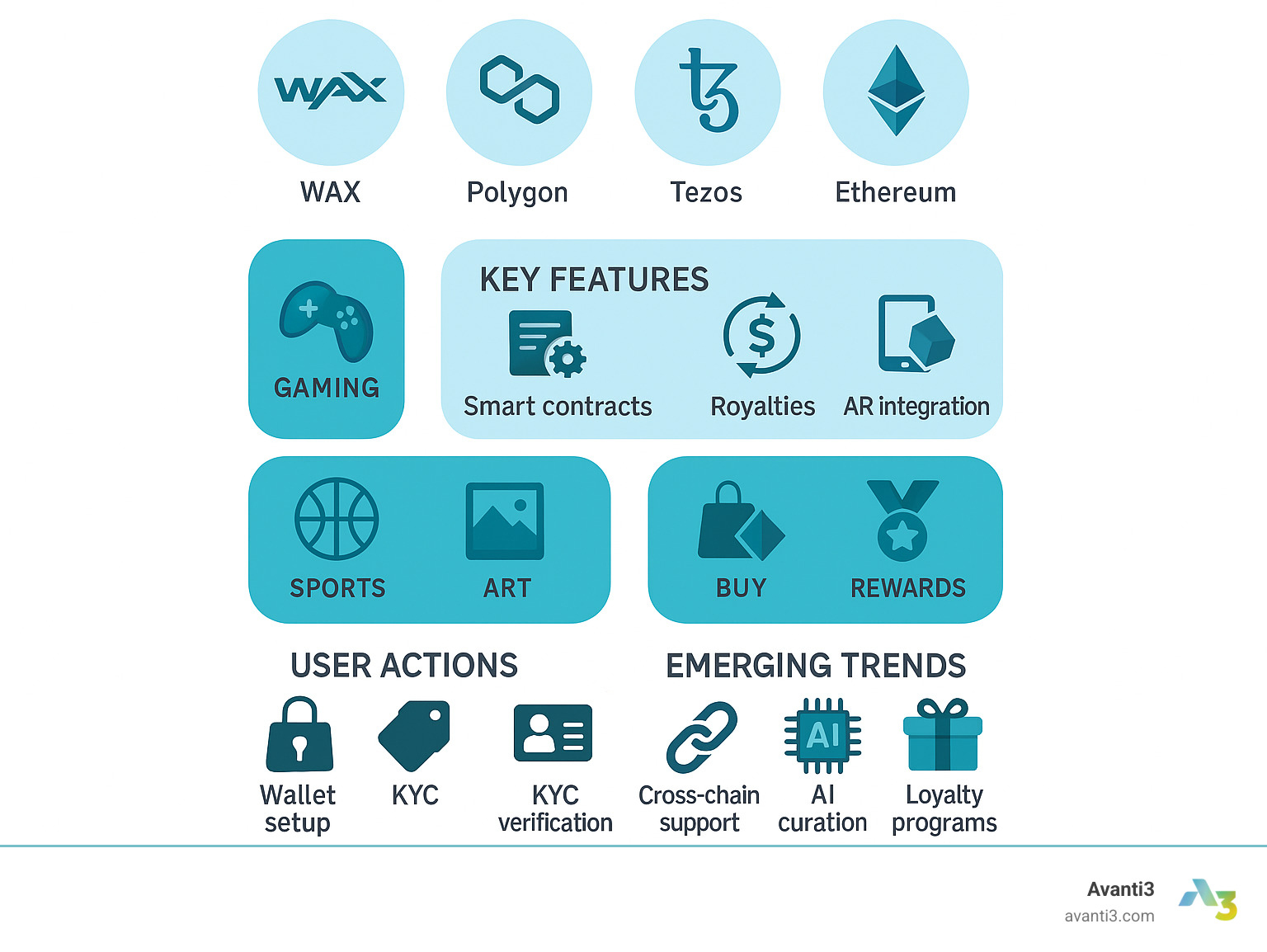
Relevant articles related to Digital Collectibles Marketplace:
– Digital asset management
– Innovative digital assets
– Interactive brand experiences
Understanding the Digital Collectibles Marketplace
Think of a Digital Collectibles Marketplace as a sophisticated digital auction house that never closes. Instead of auctioneers and paper certificates, everything runs on smart contracts – clever pieces of code that automatically handle transactions when certain conditions are met.
When you buy a digital collectible, you’re not just downloading a file. You’re getting a unique blockchain token that serves as an unbreakable certificate of ownership. It’s like having a deed to your house, but for digital art, gaming items, or sports moments.
Smart contracts handle the heavy lifting behind the scenes. They manage ownership transfers, distribute royalties to creators, and ensure every transaction is transparent and secure. No middlemen, no paperwork – just clean, automated transactions.
The provenance aspect is particularly fascinating. Every time your digital collectible changes hands, that transaction gets permanently recorded on the blockchain. It creates an unbreakable chain of ownership that goes back to the very first mint.
Most platforms work through auctions or fixed-price sales. You connect your digital wallet and start browsing. The wallet handles both your identity and payments, making the whole process surprisingly smooth once you get the hang of it.
Royalties create ongoing income for creators. Unlike traditional art where artists only get paid once, digital collectibles can generate ongoing income. Every resale automatically sends a percentage (usually 5-10%) back to the original creator.
Interoperability is becoming the name of the game. Modern platforms support multiple blockchains, letting you trade across different ecosystems without jumping through hoops.
Digital Collectibles Marketplace vs. Traditional Collecting
The contrast between digital and traditional collecting is like comparing email to handwritten letters – both have their charm, but one is clearly built for the modern world.
Edition sizes work completely differently in the digital space. Traditional prints might have 100 or 500 copies, but digital collectibles can range from unique 1/1 masterpieces to massive drops of thousands. Digital scarcity is mathematically guaranteed by the blockchain.
Physical storage headaches disappear completely. No more worrying about humidity, temperature, or damage. Your digital collection lives safely on the blockchain, accessible from anywhere with an internet connection.
The instant resale capability transforms the entire collecting experience. Traditional auction houses might take weeks to process a sale, but digital marketplaces complete transactions in minutes.
Global access breaks down geographic barriers completely. Whether you’re in Tokyo or Toledo, you have the same access to drops, auctions, and rare finds.
Key Components of a Digital Collectibles Marketplace
On-chain metadata is the DNA of digital collectibles. This includes all the important details – rarity traits, creation date, ownership history, and properties. Storing this information directly on the blockchain means your collectible’s details survive even if the original platform disappears.
Fee structures vary wildly across platforms. Most marketplaces charge a commission (typically 2.5-5%) on sales, plus blockchain transaction fees called gas costs. These fees can be unpredictable – sometimes pennies, sometimes surprisingly expensive during network congestion.
KYC (Know Your Customer) requirements are becoming standard practice. While identity verification adds an extra step, it brings legitimacy and security to the space.
Smart-contract escrow eliminates trust issues between buyers and sellers. When you place a bid, the contract holds your funds safely. If the sale completes, money flows to the seller automatically.
Research on digital ownership psychology reveals that we form genuine emotional connections with digital assets. The same psychological drivers that make physical collecting satisfying work just as powerfully in the digital field.
Mapping the 2025 Landscape of Marketplace Categories
The Digital Collectibles Marketplace world has grown into something pretty amazing. What started as simple art trading has blossomed into specialized communities, each with their own flavor and purpose.
Understanding these categories helps you find your tribe and make smarter collecting decisions. Whether you’re drawn to stunning digital art, epic gaming gear, or iconic sports moments, there’s a marketplace designed just for you.
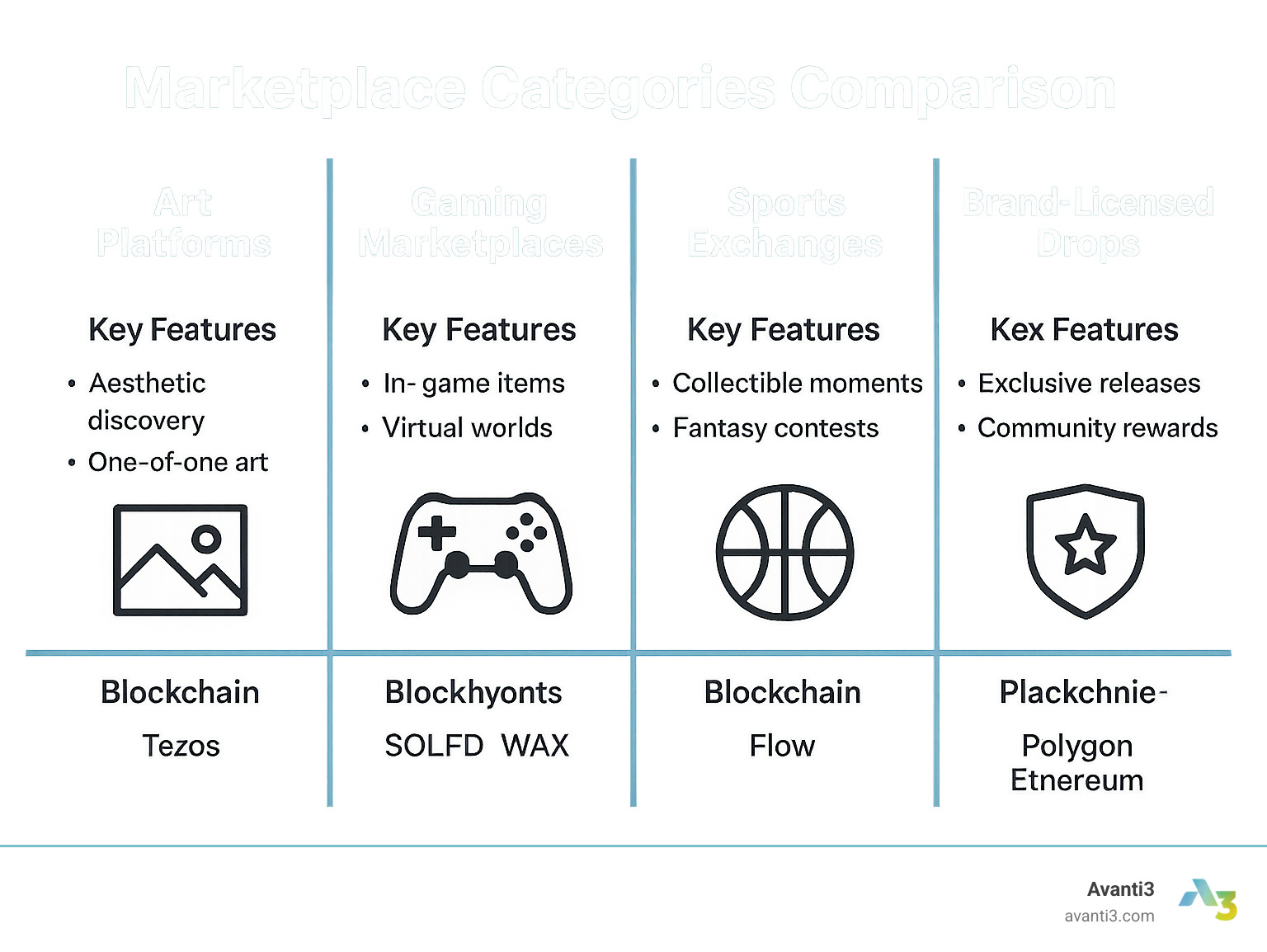
The fees and features vary wildly between different blockchain networks. WAX offers nearly free transactions perfect for gaming, while Tezos provides eco-friendly options for art lovers. Polygon strikes a balance with low fees and broad compatibility, and Ethereum remains the premium choice despite higher gas costs.
Art & Culture Platforms
Art marketplaces feel like walking through a digital gallery where creativity knows no bounds. Leading platforms have become the heart of various blockchain art scenes, where collectors can find incredible pieces without breaking the bank on transaction fees.
One-of-one (1/1) art represents the crown jewels – unique pieces that exist nowhere else in the digital universe. These command premium prices and often come with special perks like private collector events.
Generative art sets have taken the scene by storm. Algorithms create thousands of unique variations from a single concept, with each piece sharing family traits while maintaining its own personality.
Silent auctions add strategy and suspense. You can’t peek at other bids, turning each auction into a psychological chess match that often pushes prices higher than expected.
Gaming & Metaverse Marketplaces
Gaming marketplaces have completely changed how we think about virtual items. Leading platforms process significant daily trading volumes, showing the real value players place on digital gaming assets.
Play-to-earn items flip gaming on its head. Instead of just playing for fun, your skills and time investment create real value. That legendary sword you earned through countless battles? You can sell it to someone who’d rather buy than grind.
Interoperable skins work like universal keys – one weapon skin might work across multiple games, creating economies that span entire gaming universes.
Seasonal drops create collecting events tied to game updates and special occasions. The limited-time nature builds excitement and urgency.
Sports & Entertainment Exchanges
Sports marketplaces tap into our love for our teams and favorite players. Basketball and hockey highlights have started this revolution, bringing sports intensity to collectors.
Video moments capture pure sports magic in collectible form. Each highlight includes authentic game audio and multiple visual layers – it’s like owning a piece of sports history that plays on repeat.
Player coins and team-specific items let fans collect their heroes. The emotional connection runs deep – when your favorite player scores the game-winner, owning their digital moment feels incredibly personal.
Tiered rarity systems create clear value ladders with familiar terms and distinct visual indicators.
Brand-Licensed & Phygital Drops
Licensed marketplaces partner with household names to create officially sanctioned digital treasures. Major entertainment and lifestyle brands now offer digital collectibles.
Exclusive IP access means these aren’t just pretty pictures – they’re official pieces of beloved franchises carrying decades of cultural impact.
Physical redemption creates fascinating bridges between digital and physical worlds. Some digital collectibles transform into real-world items.
AR wearables and virtual items gain value through actual utility, letting you place digital collectibles in real environments for shareable moments.
How to Buy, Store & Showcase Your Digital Treasures
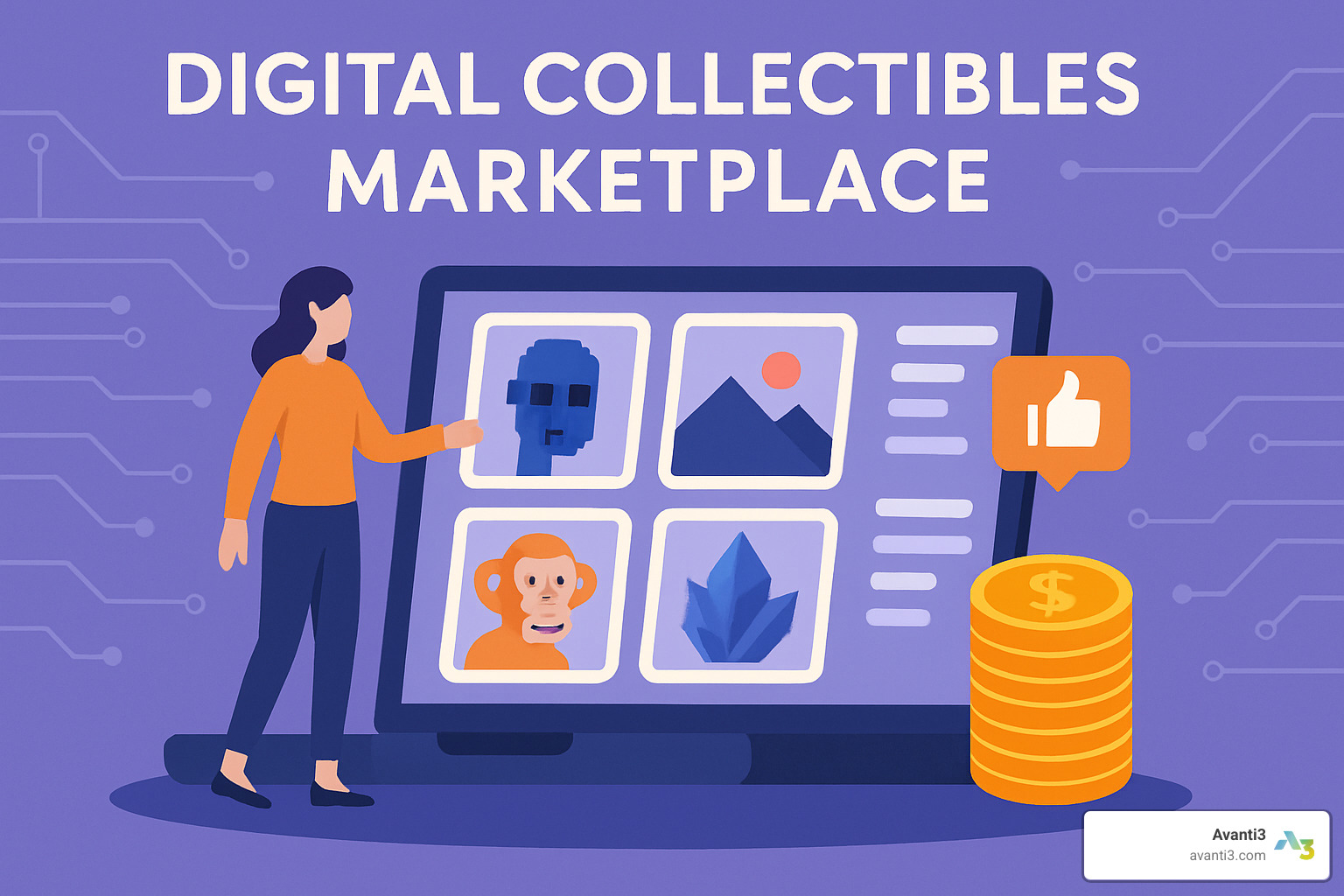
Starting your journey in a Digital Collectibles Marketplace might feel overwhelming at first, but it’s actually simpler than you’d think. The key is understanding the basics of wallet setup and security before diving into your first purchase.
Think of your digital wallet as your passport to the collectibles world. Just like you wouldn’t travel without proper documentation, you shouldn’t start collecting without a secure wallet. The good news? Once you’ve got the hang of it, buying digital collectibles becomes as easy as online shopping.
Step-by-Step Buying Flow
Your first step is funding your wallet with the right cryptocurrency. Each platform has its preferred currency – AtomicHub runs on WAX tokens, NBA Top Shot accepts regular credit cards (making it super beginner-friendly), while Objkt uses Tezos tokens. Don’t worry about memorizing all this; each platform clearly shows what payment methods they accept.
Browsing listings is where the fun begins. Most marketplaces organize their treasures by collection, rarity, price, and what’s trending. Hot items and popular collections usually get prime real estate on the homepage, so you’ll spot the exciting stuff right away.
When you’re ready to place your bid or buy something outright, your wallet springs into action. You’ll see a clear breakdown showing the item price, marketplace fees, and any blockchain transaction costs. Always double-check these numbers – blockchain transactions can’t be undone, so it pays to be careful.
Transaction confirmation happens pretty quickly on most networks. Tezos usually wraps things up in a few minutes, though Ethereum can take longer when the network gets busy. Once everything’s confirmed, your new collectible shows up in both your wallet and your marketplace profile.
The best part? Viewing your collection becomes its own form of entertainment. VeVe offers virtual showrooms where you can arrange your digital treasures like a personal museum, while other platforms provide clean gallery views or connect with portfolio tracking tools.
Managing Your Collection Securely
Security isn’t just important – it’s everything when you’re dealing with valuable digital assets. The recent closure of Quidd, which gave users until January 31, 2025, to withdraw their funds, serves as a reminder that controlling your own assets matters more than convenience.
Your seed phrase is like the master key to your digital kingdom. This string of 12 or 24 words gives complete access to your funds and collectibles. Write it down on paper (not on your computer), store copies in different safe places, and never, ever share it with anyone. Treat it like your social security number – but even more carefully.
For collections worth serious money, hardware wallets are worth every penny. These little devices keep your private keys completely offline, making them impossible for hackers to reach through the internet. Think of them as a high-tech safe for your digital valuables.
Cold storage takes security to the next level by keeping your most valuable pieces completely disconnected from online networks. It’s like keeping your rare baseball cards in a safety deposit box instead of your bedroom drawer.
Virtual showrooms are revolutionizing how collectors display their treasures. Instead of keeping your collectibles hidden in a wallet, you can create stunning displays that friends and fellow collectors can visit and admire. Some platforms even let you host virtual gallery openings – pretty cool for the digital age.
Recovery planning might sound boring, but it’s saved countless collectors from heartbreak. Test your backup methods with small amounts first, and make sure you can recover your wallet if your main device breaks or gets lost.
More info about NFT Engagement Tools can help you find new ways to showcase and interact with your digital collectibles beyond basic ownership.
Costs, Risks & Rewards in a Digital Collectibles Marketplace
Let’s be honest – diving into the Digital Collectibles Marketplace world isn’t just about the fun of collecting. There’s real money involved, and understanding the costs upfront can save you from unpleasant surprises.
Marketplace commissions are your first cost consideration. Most platforms take their cut – typically between 2.5% to 5% of each sale. If you’re planning to trade actively, these percentages add up quickly.
Gas fees are the wild card of digital collecting. These blockchain transaction costs can be your best friend or worst enemy. On Ethereum-based platforms, fees can jump from $10 to $100+ when the network gets busy. This unpredictability is why many platforms have moved to more efficient blockchains.
Creator royalties represent an interesting balance in the ecosystem. While it’s wonderful that artists earn 5-10% on every resale, it does eat into your profits when selling.
Market volatility adds complexity. Your collectible might be priced in ETH, but if ETH’s value swings 20% overnight, your collectible’s dollar value changes too.
Tax reporting is crucial. Many countries now treat NFT sales as capital gains, so keeping detailed records isn’t just good practice – it’s legally necessary.
Scams remain a persistent threat. Education and vigilance are your best defenses against fraudulent projects and fake marketplaces.
Understanding Rarity & Edition Size
Rarity in digital collectibles works differently than you might expect. It’s not just about how few exist – it’s about how the scarcity is created and perceived.
Algorithmic traits drive rarity in generative collections. Each characteristic has a specific probability of appearing, creating mathematical rarity.
Mint numbers add their own appeal. Being #1 in any collection often carries premium value, and collectors love “angel numbers” like #111, #333, or #777.
Scarcity scores help make sense of complex trait combinations through mathematical calculations that give objective rarity rankings.
Collector demand ultimately rules everything. A technically rare piece might sit unsold while a common piece from a beloved collection sells for premium prices.
Future Trends to Watch
The Digital Collectibles Marketplace landscape evolves constantly, and several exciting trends are reshaping how we collect and interact with digital assets.
Cross-chain swaps are becoming essential as collectors want flexibility. Multi-blockchain support shows where the industry is heading.
Dynamic NFTs represent the next evolution. Imagine sports cards that update with real-time player statistics, or gaming items that evolve based on achievements.
AI curation is becoming essential as the number of available collectibles grows overwhelming. Smart algorithms learn your preferences and suggest pieces you might want.
Loyalty rewards are gamifying the entire experience. Platforms now offer tokens and points for trading activity, creating additional value beyond the collectibles themselves.
Carbon-neutral minting addresses environmental concerns. Newer blockchains and carbon offset programs are making collecting more sustainable and socially responsible.
Frequently Asked Questions about Digital Collectibles Marketplace
Let’s address the most common questions collectors ask when stepping into digital collectibles. These answers will help you make informed decisions and avoid costly mistakes.
What blockchains do most marketplaces use?
The blockchain world has grown far beyond just Ethereum, and that’s great news for collectors. While Ethereum still hosts many high-value art pieces and established collections, those infamous gas fees have pushed both platforms and users toward friendlier alternatives.
WAX has become the go-to choice for gaming collectibles. AtomicHub processes over 212,400 WAX in daily volume just for collections like Alien Worlds. The best part? Transaction fees are practically zero, making it perfect for frequent traders who don’t want fees eating into their profits.
For eco-conscious collectors, Tezos powers platforms like Objkt with carbon-neutral transactions and minimal fees. You’ll regularly see healthy sales in the 100-1,300 ꜩ range, proving that sustainable doesn’t mean less valuable.
Polygon offers the best of both worlds – full Ethereum compatibility with dramatically lower costs. Meanwhile, Immutable X and Immutable zkEVM focus specifically on gaming and NFT applications, offering zero gas fees for users. Solana has also gained serious traction thanks to its speed and low costs, though it’s had some network hiccups during busy periods.
The trend is clear: platforms are moving toward blockchains that prioritize user experience over technical prestige.
How does KYC impact my trading experience?
Know Your Customer (KYC) verification is becoming the standard across serious marketplaces. Platforms like Rialto now require identity verification before you can start trading, and while it adds a step to getting started, it’s actually a good thing for the ecosystem.
The process itself is straightforward but requires patience. You’ll need to upload a government ID and proof of address, then wait 24-48 hours for approval. During this time, you can browse and research, but you can’t make any trades yet.
Once verified, you’ll notice several benefits. The platform feels more legitimate and professional. You’ll face less risk from fraudulent sellers, and you’ll often get access to premium features and higher transaction limits that unverified users can’t access.
The drawbacks are mainly about privacy and convenience. You’re sharing personal information with the platform, which creates potential data security concerns. Some collectors specifically seek out platforms with minimal KYC requirements, though these often come with limited functionality or higher risks.
The reality is that KYC is becoming unavoidable as the industry matures and regulators pay more attention to digital asset trading.
Are digital collectibles environmentally sustainable?
This question used to be a major concern, but the Digital Collectibles Marketplace ecosystem has made tremendous progress on sustainability. The early criticism focused on Bitcoin and Ethereum’s massive energy consumption, but today’s landscape looks completely different.
Proof-of-stake networks like Tezos and Polygon consume 99% less energy than the old proof-of-work systems. When you buy a collectible on Objkt, you’re using one of the most environmentally friendly platforms available.
Many platforms now participate in carbon offset programs, purchasing carbon credits to neutralize their remaining emissions. Some have even achieved carbon negativity, meaning they remove more carbon from the atmosphere than they produce.
Layer 2 solutions have revolutionized Ethereum-based platforms by processing transactions off-chain and settling them in batches. This dramatically reduces the energy needed per transaction without sacrificing security.
The industry has clearly chosen sustainability as a priority. Almost every new platform launches on eco-friendly blockchain networks, and existing platforms are actively migrating to greener alternatives.
For collectors who care about environmental impact, you now have plenty of sustainable options that don’t compromise on features or security. The days of choosing between collecting and environmental responsibility are behind us.
Conclusion
The Digital Collectibles Marketplace revolution is reshaping how we connect with art, entertainment, and each other in ways we’re only beginning to understand. What started as simple digital trading cards has evolved into immersive experiences where fans can own pieces of their favorite games, sports moments, and cultural phenomena.
Think about it – just a few years ago, the idea of owning a basketball highlight or displaying Marvel collectibles in augmented reality seemed like science fiction. Today, platforms like NBA Top Shot and VeVe make these experiences part of daily life for millions of collectors worldwide.
The technology powering these marketplaces continues advancing at breakneck speed. Smart contracts now handle complex royalty distributions automatically, while cross-chain interoperability lets you move your collectibles between different blockchain networks seamlessly. We’re seeing the emergence of dynamic NFTs that evolve based on real-world events and AI curation systems that help you find exactly what you’re looking for.
But perhaps most importantly, these platforms are empowering creators like never before. Artists can now reach global audiences directly, earning ongoing royalties from every resale. Game developers can create sustainable economies where players truly own their in-game achievements. Sports leagues can offer fans new ways to celebrate their favorite moments.
The challenges are real, though. Platform closures like Quidd remind us that not every marketplace will survive the test of time. Gas fees, market volatility, and regulatory uncertainty continue creating problems for both creators and collectors. Success in this space requires understanding these risks while staying focused on the incredible opportunities ahead.
At Avanti3, we’ve witnessed how Web3 technologies including NFTs, blockchain, AR/VR, and AI can transform creator-audience relationships. Our customizable engagement tools and fintech solutions help brands and creators build sustainable communities while navigating the complexities of the Digital Collectibles Marketplace ecosystem.
The future belongs to platforms that combine cutting-edge technology with genuine utility and community value. We’re already seeing early examples of carbon-neutral minting, loyalty reward systems, and virtual showrooms that blur the lines between digital and physical experiences.
Whether you’re an artist ready to monetize your creativity, a brand exploring new engagement channels, or a collector diving into this exciting world, the key is staying informed and adaptable. The Digital Collectibles Marketplace landscape rewards those who understand both the opportunities and the pitfalls.
More info about NFT Marketplace Development can help you understand how to build or integrate with these platforms effectively, whether you’re launching your own marketplace or creating branded experiences within existing ecosystems.
The digital collecting revolution is just getting started. Those who accept the technology while focusing on real value creation will shape the next chapter of this incredible story.

